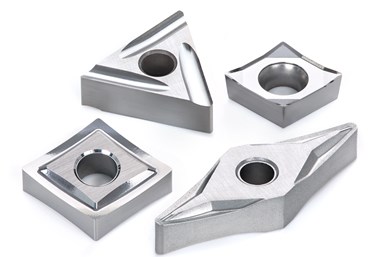Negative Inserts Improve Productivity in Non-Ferrous Metal Machining
Tungaloy expands its economical, double-sided negative insert line with the -28 chipbreaker.
Share







ECi Software Solutions, Inc.
Featured Content
View More
Hwacheon Machinery America, Inc.
Featured Content
View More
Autodesk, Inc.
Featured Content
View MoreTungaloy America Inc. has enhanced its uncoated cemented carbide insert line for non-ferrous applications by adding 13 new inserts with the -28 chipbreaker.
Aluminum alloys are the most common weight reduction materials in the automotive and aerospace industries, which are said to be so machinable that uncoated carbide inserts can generally provide extremely long tool life. Likewise, copper alloys are widely used for seals, gaskets and o-rings in plumbing applications.
Conventional machining methods of non-ferrous metal parts employ positive turning inserts with a high positive rake and sharp cutting edges. These inserts, however, can only be used on one side, thus generating higher cost per edge and part.
Tungaloy says it addresses the issue by expanding the economical, double-sided negative insert line with the -28 chipbreaker. Featuring a pressed-in chipbreaker geometry with a large inclination angle on the sharp cutting edge, the -28 reportedly generates free cutting action with superior chip control. In addition, a negative insert design provides the cutting edge with strength and reliability when machining parts with heavy cutting conditions at varying depth of cut (DOC).
The inserts are available in KS05F grade. An uncoated, cemented carbide grade with submicron grain, KS05F provides the insert with wear resistance. This enables the new negative inserts to ensure long and predictable tool life over a wide range of non-ferrous applications.
The expansion includes standard ISO turning inserts in economical Class M tolerance, as well as ground-to-size inserts for precision finishing, encompassing finish to medium cutting of non-ferrous metal parts.
Related Content
-
Orthopedic Event Discusses Manufacturing Strategies
At the seminar, representatives from multiple companies discussed strategies for making orthopedic devices accurately and efficiently.
-
Custom PCD Tools Extend Shop’s Tool Life Upward of Ten Times
Adopting PCD tooling has extended FT Precision’s tool life from days to months — and the test drill is still going strong.
-
How to Mitigate Chatter to Boost Machining Rates
There are usually better solutions to chatter than just reducing the feed rate. Through vibration analysis, the chatter problem can be solved, enabling much higher metal removal rates, better quality and longer tool life.







































